By Jon R. Sundra
Can you think of any 19th century product still being made and used today? Such is the genius of Peter Paul Mauser’s M98.
Photo: One of the finest examples of the Mauser ’98 was the 1909 contract built at the DWM factory for the Argentine government. The machining and smoothness of the action have never been surpassed in any commercial or military version.
No one can argue the fact that the ’98 Mauser has had more influence on sporting rifle design than any other centerfire rifle action. No one knows how many military Mausers were made, but estimates run as high as 100 million. Even today, enterprising arms dealers are still finding caches of ’98s in arsenals all over Europe, Asia, Central and South America.
The ’98 represents the culmination of a design evolution that began with the Mauser Model 1871, which Prussian military adopted to replace the Dreyse needle-fire rifle. The Dreyse had been that country’s martial arm since 1842, and held the distinction of being the first “bolt action” breech-loading rifle.
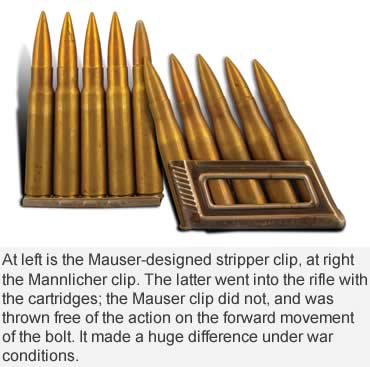 Actually, the basic mechanism is very similar mechanically to a simple door latch. Lower the bolt handle to lock the action, and the handle’s rear surface bears against an abutment shoulder in the receiver’s sidewall, locking the bolt.
Actually, the basic mechanism is very similar mechanically to a simple door latch. Lower the bolt handle to lock the action, and the handle’s rear surface bears against an abutment shoulder in the receiver’s sidewall, locking the bolt.
The ’71, which was a single-shot rifle, was chambered for one of the very first self-contained metallic cartridges, the 11mm German, which by 1877 had been adopted by all states within the new German empire. This first successful Mauser remained relatively unchanged until the Model 71/84, which was a Model 71 converted to a repeating rifle by incorporating an under-barrel tubular magazine, an extractor and an ejector.
The next landmark in the evolution leading to the ’98 came as a result of the panic that overtook Europe. In 1886, the French adopted the 8mm Lebel, the first military cartridge to use smokeless powder and jacketed bullets, along with a new rifle to handle the cartridge. Suddenly, all other martial arms using blackpowder and lead bullets were hopelessly obsolete.
Germany’s answer was the Commission Rifle of 1888. As its name suggests, it was developed by the rifle testing commission located at the Spandau Armory rather than by Paul Mauser, but it incorporated many features developed by him, including a cartridge of his design, the 8x57 or 8mm Mauser.
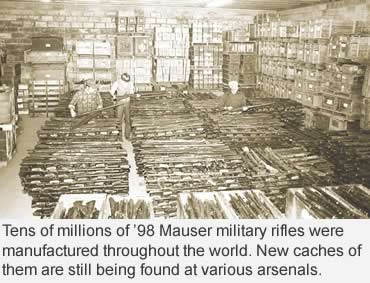 The Commission rifle was noteworthy because it introduced twin opposed locking lugs at the head of the bolt that engaged abutment surfaces in the receiver ring — a feature that still characterizes Mauser-type actions today. Gone was the slow-loading tubular magazine of the 71/84. In its place was the box magazine of Ritter von Mannlicher that allowed the clip loading of five cartridges at a time.
The Commission rifle was noteworthy because it introduced twin opposed locking lugs at the head of the bolt that engaged abutment surfaces in the receiver ring — a feature that still characterizes Mauser-type actions today. Gone was the slow-loading tubular magazine of the 71/84. In its place was the box magazine of Ritter von Mannlicher that allowed the clip loading of five cartridges at a time.
Meanwhile, Paul Mauser was perfecting his latest action, which became the Belgian Model ’89. It featured a one-piece bolt with dual-opposed locking lugs at the head, and a revolutionary magazine system. Like the Mannlicher magazine of the ’88 Commission rifle, Mauser’s magazine housing also extended down from the belly of the stock and stored cartridges in a single row, but that’s where the similarities end. With the Mannlicher, the clip holding the five rounds entered the magazine along with the cartridges. After the last round was fired, the empty clip fell by gravity through the open bottom of the housing.
With Mauser’s Model ’89, the five cartridges were held together by a much smaller clip that held the rounds together by their rims. Both magazines were charged by thumbing the five-round stack of cartridges down into the magazine, but with the Mauser, the cartridges slid out the bottom of the stationary clip. As the bolt moved forward to chamber the first round, the clip was automatically ejected.
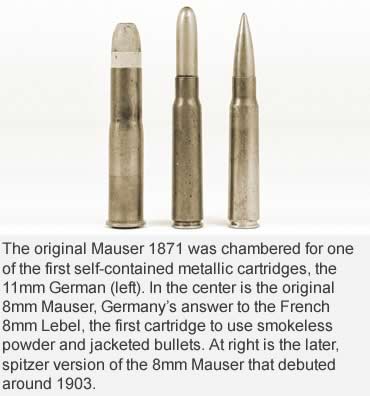 It was a far more reliable system for several reasons. Because the clip did not enter the action, it could not affect the gun’s functioning if it was bent, dirty, rusted or otherwise defective. It was also sealed at the bottom against the entry of sand and dirt, which could also affect functioning.
It was a far more reliable system for several reasons. Because the clip did not enter the action, it could not affect the gun’s functioning if it was bent, dirty, rusted or otherwise defective. It was also sealed at the bottom against the entry of sand and dirt, which could also affect functioning.
Another plus of the Mauser system is that soldiers could add individual rounds to a partially filled magazine, whereas the Mannlicher had to be emptied before it would accept another clip. The Mauser clip was incorporated into all the later versions as well as adopted by our government for the ’03 Springfield and 1917 Enfield.
Every year after the Model ’89 saw a new and improved version of Herr Mauser’s brainchild, each representing another step toward its culmination in the form of the ’98. After the Belgian ’89 came the Model ’93 or Spanish Mauser. With the ’93, the gun now had the basic outward appearance of what the ’98 would look like.
The most striking change from previous Mausers was the ’93’s staggered column box magazine. The magazine was charged with five-round clips just like the ’89, but instead of stacking cartridges in a single row, which required more depth to the box, they were staggered.
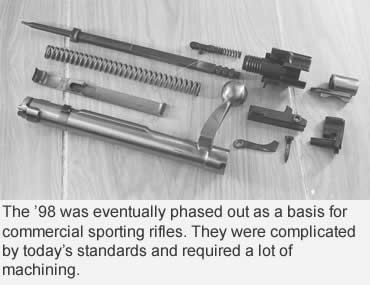 The same five rounds could now be stored in a shallower magazine that was flush with the belly of the stock. Obviously, such an arrangement offered even better protection against damage, and provided comfortable one-hand carry at the gun’s balance point.
The same five rounds could now be stored in a shallower magazine that was flush with the belly of the stock. Obviously, such an arrangement offered even better protection against damage, and provided comfortable one-hand carry at the gun’s balance point.
On the heels of the Spanish ’93 came a flurry of minor changes and improvements in the continuing evolutionary process. There were the Swedish and Turkish Model ’93s, the Brazilian Model ’94 and the Swedish Model ’96, all of which inched toward the definitive Model ’98.
There is no shortage of gunsmiths, gun makers or gun “experts” who believe there has yet to be any significant improvements over the original Mauser. Many of them contend there have been none at all. I don’t agree. Just in the area of metallurgy, surely we’ve made some progress over the last 111 years!
One is also inclined to assume we’ve come a long way in terms of precision tolerances and machining, but you’d never know it if you ever examined, say, a pristine 1909 Argentine military rifle manufactured at the DWM factory in Berlin, or the Brazilian Model 1908 made in Oberndorf. I own one of each, and I can tell you that, with all the computer-controlled and EDM processes used to produce contemporary firearms, the quality of machining and the finish found on today’s production rifles rarely ever matches, let alone surpasses, that seen of these guns that were produced a century ago. It is mind boggling.
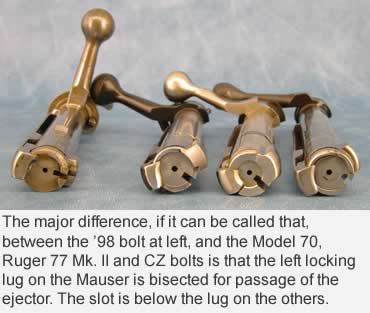 The ’98 strongly influenced the ’03 Springfield — to the point the U.S. government paid royalties to Mauser — and our ’17 Enfield, both military rifles.
The ’98 strongly influenced the ’03 Springfield — to the point the U.S. government paid royalties to Mauser — and our ’17 Enfield, both military rifles.
The first commercial sporting rifles to borrow the primary characteristics of the ’98 Mauser were those of Charles Newton, introduced just prior to the outbreak of WWI, and the Winchester Model 54 introduced in 1925 in conjunction with the epochal .270 Win cartridge.
When I say primary characteristics in reference to the ’98 Mauser, I mean: 1) a one-piece bolt with dual-opposed front locking lugs that engage abutments within the receiver ring; 2) a staggered column box magazine; 3) inertia ejection whereby spent cartridge cases are ejected by a static arm that contacts the rearward-moving case near the end of the bolt’s rearward travel; 4) a wing safety that withdraws the cocking piece, which is attached to the firing pin, from contact with the trigger sear, and 5) controlled-round feeding whereby the extractor takes control of the feeding cartridge the moment it clears the magazine’s feed rails.
The Newton departed a bit from the Mauser. Instead a slot bisecting the ejector on the left locking log, Newton repositioned the slot below the lug to keep from weakening it. The Winchester Model 54 also incorporated this feature, which I consider an improvement over the original Mauser. It doesn’t change the mechanics, just the positioning of the components.
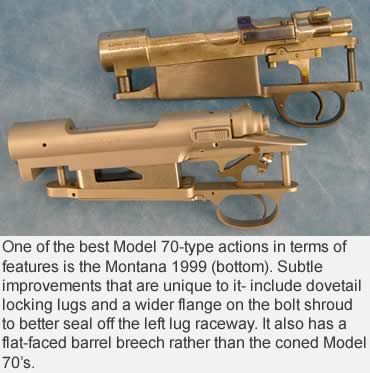 The Newton rifle was also different in that its twin-opposed locking lugs at the head of the bolt employed the interrupted thread approach which provides multiple bearing surfaces much like the Weatherby Mark V. It is, nonetheless, just a variation of the basic Mauser.
The Newton rifle was also different in that its twin-opposed locking lugs at the head of the bolt employed the interrupted thread approach which provides multiple bearing surfaces much like the Weatherby Mark V. It is, nonetheless, just a variation of the basic Mauser.
The commercial action that best represents what is a generic improvement on the original ’98 Mauser is the Winchester Model 70, introduced in 1936.
From its debut to its discontinuance in 1963, the Model 70 was the rifle against which all other bolt actions were judged. It is, nonetheless, a basic Mauser action in all its critical features. The flush bolt face and the non-rotating extractor riding sidesaddle on the bolt needed for controlled-round feeding is there, along with the same basic ejection system. But like its ancestor, the Model 54, its ejector blade does not contact the case head through a slot through the middle, but rather below the left locking lug.
As with the military ’98, the safety is on the bolt shroud. Though the ’98’s wing-style safety looks radically different than the Model 70’s, both work on the same principle: withdrawing the cocking piece/firing pin unit from contact with the trigger sear.
By popular demand, the pre-’64 Model 70 was brought back into production with minor changes and is now being produced at the FN factory in Columbia, S.C. I think it’s safe to say that it is the Model 70 and its facsimiles, the short- and long-action Kimbers, the Dakota Model 76 and the Montana Model 1999, have most faithfully carried on the Mauser legacy to the present day. They are virtual copies of the Model 70, as is the Dakota Model 97.
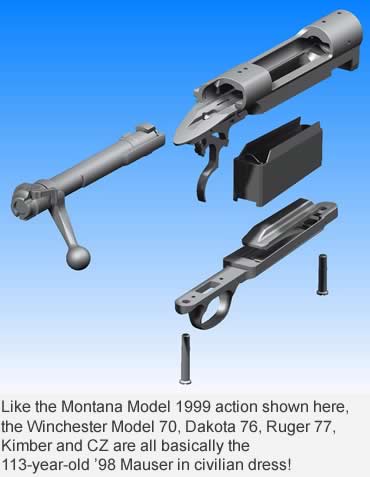 The Ruger Model 77 introduced in 1968 is basically a Mauser action, but its bolt’s recessed face and plunger ejection precluded controlled-round feeding. In 1994, the Mk II version of the Ruger 77 was introduced, and it was changed over to the Mauser feeding/ejection system. A different safety, the integral scope mount rails and angled front action screw do not change that fact.
The Ruger Model 77 introduced in 1968 is basically a Mauser action, but its bolt’s recessed face and plunger ejection precluded controlled-round feeding. In 1994, the Mk II version of the Ruger 77 was introduced, and it was changed over to the Mauser feeding/ejection system. A different safety, the integral scope mount rails and angled front action screw do not change that fact.
Czech arms producer CZ markets an extensive line of bolt-action rifles based on a modified Mauser system.
Today, the original Model ’98, i.e., without the thumb slot in the left receiver wall and a different bolt shroud, trigger and safety, is still being produced in commercial form in Serbia.
In the post-WWII era, FN in Belgium, Husqvarna in Sweden and the Spanish La Coruna arsenal were also making commercial ’98 actions and barreled actions and marketed here by various importers and distributors. Prior to the proliferation of commercial actions some 25 years ago, military Mausers were the basis for more custom rifles than all others combined.
There are still some gunsmiths today who prefer to use military ’98s as the basis for custom rifles, even to the point of re-heat treating bolts and receivers and changing external contours.
Can you think of a single consumer product that is still being produced in the same form it was 111 years ago, and is still considered by many to be state of the art? I can’t.
And let’s not forget that Paul Mauser’s 8x57 cartridge is the basis for countless European metric cartridges, the .30-06 family, and with minor changes to the extractor groove, the .308 Win family.
Just think, every cartridge with the .30-06’s .472-inch head diameter, from the .22-250 to the .35 Whelen, are all based on the basic 8mm Mauser case either shortened or lengthened. Talk about epochal contributions to firearms technology!
Read Recent GunHunter Articles:
• Return of the Bolt-Action Slug Gun: Turnbolt shotguns are the hottest tickets in slug gun shooting today.
• Muzzleloader Myths: Voodoo ballistics and other misconceptions still abound in blackpowder shooting.
This article was first printed in the August 2011 edition of Buckmasters GunHunter Magazine. Subscribe today to have GunHunter delivered to your home.